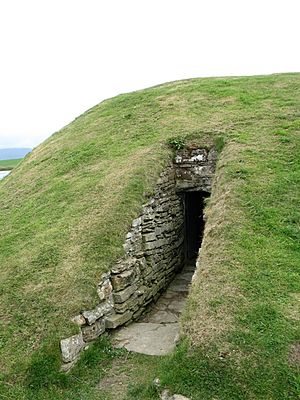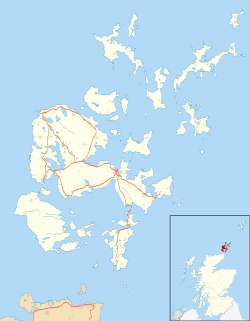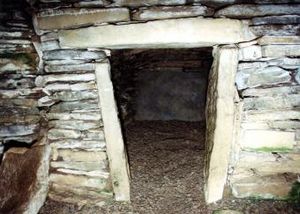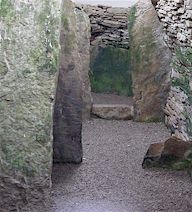Unstan Chambered Cairn facts for kids

Entrance to Unstan Chambered Cairn
|
|
| Location | Mainland, Orkney, Scotland |
|---|---|
| Coordinates | 58°59′11″N 3°14′57″W / 58.9863°N 3.2492°W |
| Type | Neolithic chambered cairn |
| History | |
| Periods | Neolithic |
| Site notes | |
| Public access | Yes |
| Reference no. | SM90232 |
Unstan (also called Onstan or Onston) is a very old stone tomb found in Mainland, Orkney, Scotland. It's about 2 miles (3 km) north-east of a town called Stromness. This tomb was built a very long time ago, during the Neolithic period, which is also known as the New Stone Age.
The tomb sits on a piece of land that sticks out into the Loch of Stenness. Unstan is special because it's a mix of two different types of ancient tombs found in Orkney. It's also where a unique type of pottery was first discovered. This pottery is now named after the tomb: Unstan ware. Today, Historic Environment Scotland looks after Unstan as a protected historical site.
Contents
What is Unstan Cairn?
Unstan is a very well-preserved example of a chambered cairn from the Orkney-Cromarty style. These tombs are often called "stalled" cairns. This is because their inside looks a bit like horse stalls. They have a main path with stone slabs on each side. These slabs divide the space into small rooms or compartments.
The first stalled cairns were found in a place called Caithness. They usually had up to four compartments. In Orkney, these tombs became much bigger and more complex. For example, the Knowe of Ramsay on Rousay has fourteen compartments!
Unstan is a smaller stalled cairn with five compartments. These rooms are on either side of a path that is about 6.4 metres (21 ft) long. Like most old tombs in Orkney, the original roof is gone. A new concrete roof was added in the 1930s to protect the site. The remaining walls are almost 2 metres (6.6 ft) high. They are made from thin, flat stones called flagstone, which come from the local Devonian Old Red Sandstone.
Unique Features of Unstan
Unstan is a bit different from other Orkney-Cromarty chambered cairns in a few ways.
- First, the barrow (or burial mound) that covers the tomb is round. It is about 13 metres (43 ft) across. Most other tombs of this type are long or rectangular.
- Second, the round shape is because Unstan has a side chamber. This feature is more common in a different type of tomb called Maeshowe tombs.
- Third, the main chamber of Unstan doesn't open at the end of the path. Instead, it opens along one of the long sides. This is also more like the Maeshowe tombs.
The mound itself is built from two or three circles of stone walls. Other tombs nearby suggest that Unstan was built between 3400 and 2800 BC.
Unstan Ware Pottery
Unstan is famous because a special kind of pottery was first found here in 1884. These pots are now known as Unstan ware. Unstan ware pots are usually elegant, shallow bowls. They have a pattern of grooves just below the rim. This pattern was made using a "stab-and-drag" method. There was also a simpler version of these bowls that were round at the bottom and had no decoration.
Some of these bowls were made stronger by adding small pieces of volcanic rock to the clay. After the pots were baked, bone tools were used to polish them. This made the surfaces shiny and waterproof.
Archaeologists found parts of twenty to thirty bowls in the tomb. Many of them were Unstan ware. Most of the bowls were broken or incomplete. This is common in these ancient tombs. It suggests that the pots were broken on purpose to be placed with the dead. These bowls were not new when they were put in the tomb. They had clearly been used before. For example, some broken pieces had marks from barley grains. Many fragments were found in a shallow dip in the clay floor, a pattern seen in other tombs. Some of the bowls have been put back together and are now in the National Museum of Scotland.
What Was Found Inside?
Human remains were found inside Unstan. There were two skeletons curled up in the side room. Several more skeletons were in the main part of the tomb. Many other bones were scattered throughout the rest of the tomb. Animal bones and charcoal (burnt wood) were also found.
It's possible that Unstan was used for a very long time, even into the second millennium BC. An arrowhead found in the tomb belongs to the Beaker People. These people lived from the end of the Stone Age into the Bronze Age. Also, burying people in a curled-up position was not common during the Neolithic period.
What's in a Name?
The second part of the name, stan or ston, comes from an old Norse word. In the Norse language, the word stadr means a farm settlement. This is a special way of saying it in Orcadian, which is the local dialect of Orkney.
See also
 In Spanish: Cairn de cámaras de Unstan para niños
In Spanish: Cairn de cámaras de Unstan para niños




